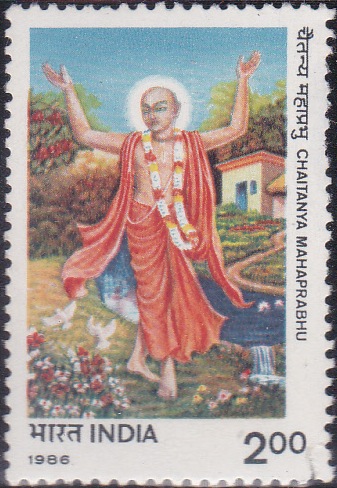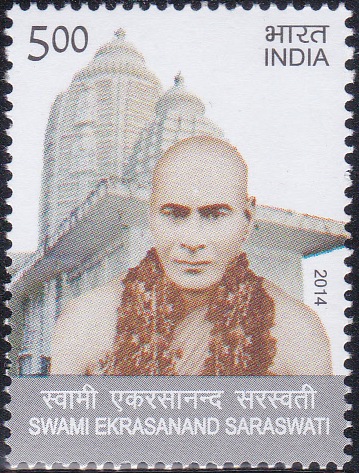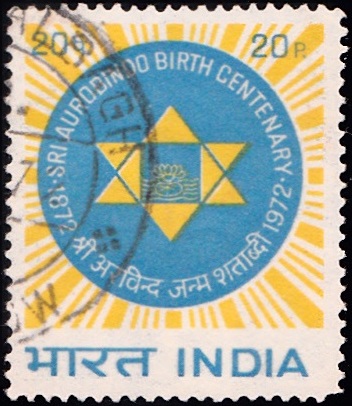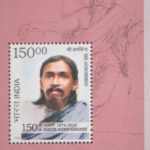
Bhakti Siddhanta Saraswati
A commemorative postage stamp on the 150th Birth Anniversary of Srila Bhaktisiddhanta Saraswati Prabhupad, the Lion Guru of ISKCON (International Society for Krishna Consciousness) :
 Issued by India
Issued by India
Issued on Feb 8, 2024
Issued for : Department of Posts is pleased to issue Commemorative Postage Stamp on 150th Birth Anniversary of Srila Bhaktisiddhanta Saraswati Prabhupad and salutes his immense contribution in the spiritual upliftment of millions in India and abroad.
Credits :
Stamp/FDC/Brochure : Shri Suresh Kumar
Cancellation Cachet : Shri Suresh Kumar
Type : Stamp, Mint Condition
Colour : Multi Colour
Denomination : 500 Paise
Stamps Printed : 201600
Printing Process : Wet Offset
Printer : Security Printing Press, Hyderabad
Name : Bimala Prasad Datta
Born on 6 Feb, 1874 at Puri, Bengal Presidency, British India [now in Odisha, India]
Died on 1 Jan, 1937 at Calcutta, Bengal Presidency, British India [now in West Bengal, India]
About :
- Born on 6th February 1874 in Puri, as the seventh child of Sri Kedarnath Dutta and Bhagwati Devi, Srila Bhakti Siddhanta Saraswati Goswami Prabhupad was provided many name. His given name was Bimala Prasad, which was conferred upon him at time of his birth in 1874 by his father Sri Kedarnath Dutta, who later came to be known as Srila Bhakti-Vinode Thakur. During his lifetime, he often used to sign as ‘Siddhanta Saraswati’. As mentioned in one Sanskrit book, he is also referred as ‘Sri Varshabhanavi-Dayita-Das’. Gaudiya Vaishnava Sampradaya recognizes him as Srila Prabhupad to this date.
- He started his formal education at an English school at Ranaghat, in the district of Nadia, present day West Bengal. From his very childhood days, his spiritual inclination was remarkable. At the age of nine he memorized seven hundred verses of the Bhagavad Gita in Sanskrit. From his early childhood, Bimala Prasad demonstrated a sense of strict moral behaviour, a sharp intelligence, and an eidetic memory.
- In early 1880, he was initiated by his father into Harinama-japa, a traditional Gaudiya Vaishnava practice of meditation based on the soft recitation of the Hare Krishna mantra on Tulsi beads. In the year 1887, he joined Calcutta Metropolitan Institution (Vidyasagar College) and received modern education to compete with others. While studying the compulsory subjects, he also pursued sanskrit, mathematics and jyotisha (traditional Indian astronomy). His proficiency in these subjects was soon recognized by his tutors and he was awarded the honorary title “Siddhanta Saraswati”, which he adopted as his pen name from then on. Thereafter, he entered Sanskrit College, one of finest institutions in Calcutta where he added Indian philosophy and ancient history to his study list.
- In January, 1901, Srila Bhaktisiddhanta Saraswati Goswami accepted Gour Kishore Das Babaji, as his spiritual master and received a new name Varsha Bhanavi-devi-Daita Dasa. After passing away of his father and his Guru to the spiritual world, Bimala Prasad accepted Sanyas and started to be known as Bhaktisiddhanta Saraswati Goswami. Thereafter, he went on a pilgrimage of India’s holy places.
- In India, the spiritual life of the people was plagued by the prevalent ugly religious practices and dogma. Srila Prabhupad was the first spiritual reformer who revived the tenet of Vaishnavism, the religion of humanity and universal brother hood, as propounded by Sri Chaitanya Mahaprabhu. He spearheaded one of the most powerful reformist movements of the 20th century through establishment of Gaudiya Math in 1918. This movement paralleled the efforts of Swami Vivekananda establishing Ramkrishna Mission. Srila Prabhupad’s movement presently extents throughout the World.
- Srila Prabhupad was a preacher and preserver of “the world Hare Krishna movement. Today this movement is praised throughout the world for rich Indian culture. He also spread the doctrines of universal brotherhood and peace. In the present violence ridden world, Srila Prabhupad’s profound preaching of Vaishnavism is the epitome of non-violence. In a world filled with conflict, intolerance, and violence, his teachings offer a new perspective on the importance of non-violence and compassion. The principles of Vaishnavism, emphasizing devotion to Lord Krishna and universal brotherhood, provide a foundation for fostering peace and understanding among all living beings.
- To propagate the teachings of Sri Chaitanya Mahaprabhu, he published spiritual magazines and daily newspaper, like Sajjan Toshini/ Harmonist, Gaudiya, Dainik Nadia Prakash in Bengali, Bhagbat in Hindi, Kirtan in Asamese and Paramarthi in Odiya. He also established number of printing press in different places to facilitate printing of these publications and other Vaishnava texts.
- He sent preaching envoys to London and other countries in Europe. To set the tune, in the year 1933, Shri Krishna Chaitanya, a voluminous English language book, portraying Sri Chaitanya Mahaprabhu as the protagonist of Bhakti, was released for distribution targeting the western elites. Srila Prabhupad organized several Bhagavat Exhibitions, together with Agricultural and Industrial fete at different places in India depicting local theme to educate people.
- In the year 1935, Para Vidya Peeth, conveying the best and the highest form of all education – the education of self-realization along with ‘Love for All’ at the cost of egoistic attitudes, following in the foot-steps of Sri Krishna Chaitanya Mahaprabhu, was establish at Gaudiya Mission Bagbazar. He also established several other Education and Research Institutions including, Thakur Bhakti Vinode Institute, a residential public High School and Thakur Bhakti Vinode Research Institute” for encouraging research and advanced studies in the teachings of Srila Thakur Bhakti Vinode and Gaudiya Vaishnav literature in general.
- Srila Prabhupad vehemently opposed customary Hindu cast restrictions on social background as religious eligibility and the exclusive right of the cast Brahmins to interpret religious texts and advocated the view that Vishnu Temples should be opened for everyone. He brought about a social transformation by removing all sectarian divides including traditional Varnashrama concept, orthodox religious practices, superstitions and dogma prevalent in the spiritual life of the people in India.
- Srila Prabhupada was a great thinker and his literary skills were remarkable. He influenced a group of well-educated adherents with missionary zeal, who joined him to carry forward his movement, particularly in India and as well as the western world. Great freedom fighters like Netaji Subhas Chandra Bose, Dr. Shyama Prasad Mukherjee, Tripuradhis Maharaja Manikya Bahadur, Sri Madan Mohan Malviya and Raja Gopalachari were influenced by his social and spiritual work and believed that spiritual inspiration to the youth was vital for the independence of India.
- On 1st January 1937 Srila Bhaktisidhanta Saraswati Goswami Prabhupad departed from this mundane world leaving his legacy of right way of devotional practices based on the ancient vedic scriptures.
- Text : Referenced from content provided by Proponent.







